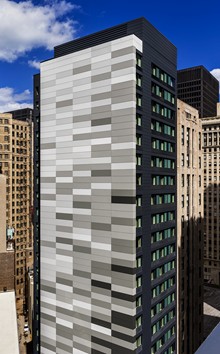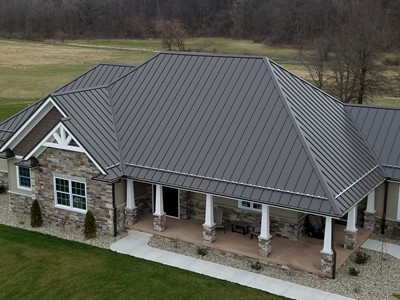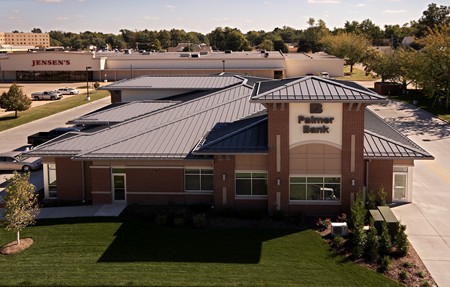How Prepainted Metal Meets The Needs Of Fabricators
By Derek Deakins, National Coil Coating Association Marketing Committee Chair
With its nearly endless color and texture possibilities, eco-friendliness and durability, prepainted metal’s popularity is on the rise when compared to other materials. With the technological demands of modern fabrication techniques, manufacturers may wonder if this new trend of greater use of prepainted metal can handle the rigorous processes of manufacturing, such as embossing and rollforming, while maintaining adherence to government regulations. Prepainted metal is proven to meet and exceed these requirements across the board.
 Now, more and more fabricating work is done on the painted metal substrate because many customers don’t want the panel to look like a simple, painted metal panel. Instead, customers want panels that have the appearance of a slate shingle or a piece of tile. As a result, there is a lot more bending and elongation, so prepainted metal is already meeting the demands of the fabrication process in many ways.
Now, more and more fabricating work is done on the painted metal substrate because many customers don’t want the panel to look like a simple, painted metal panel. Instead, customers want panels that have the appearance of a slate shingle or a piece of tile. As a result, there is a lot more bending and elongation, so prepainted metal is already meeting the demands of the fabrication process in many ways.
Here are just some of the ways prepainted metal meets the challenges faced by fabricators of building and other materials.
Prepainted Metal Meets Durability Requirements
 The durability requirements of prepainted metal are expressed typically in terms of color fade and degree of chalking, both which have to do with maintaining the aesthetic appearance of a prepainted metal panel. The warranties for prepainted metal roof panels are in the range of 20, 40 and even up to 45 years, significantly longer than for shingle roofs. Prepainted coatings are designed to be scratch-resistant and will not crack or split. Prepainted panels are designed to be sufficiently flexible to meet the demands of complex shapes. Prepainted metal panels are designed to withstand harsh weather and provide excellent corrosion resistance with the use of state-of-the art pretreatments and multiple coatings. The coatings are applied to both sides of the metal to enhance its long-term durability. Prepainted products are designed to be scratch-resistant and reduce the appearance of oil canning, dents, and other imperfections found on long panels.
The durability requirements of prepainted metal are expressed typically in terms of color fade and degree of chalking, both which have to do with maintaining the aesthetic appearance of a prepainted metal panel. The warranties for prepainted metal roof panels are in the range of 20, 40 and even up to 45 years, significantly longer than for shingle roofs. Prepainted coatings are designed to be scratch-resistant and will not crack or split. Prepainted panels are designed to be sufficiently flexible to meet the demands of complex shapes. Prepainted metal panels are designed to withstand harsh weather and provide excellent corrosion resistance with the use of state-of-the art pretreatments and multiple coatings. The coatings are applied to both sides of the metal to enhance its long-term durability. Prepainted products are designed to be scratch-resistant and reduce the appearance of oil canning, dents, and other imperfections found on long panels.
“I think we sometimes underestimate what these paints have to go through to meet the demands of manufacturers,” said Michelle Vondran, quality systems manager at Steelscape. “There’s an expectation that there will be little variation from coil-to-coil, so we work closely with the substrate supplier, coating application process, and coating supplier. To ensure consistency, they all have to be on the same page.”
Prepainted Metal Improves Manufacturing Processes
Today’s prepainted metal processes are designed to withstand many familiar fabrication processes, including roll forming, stamping and embossing.
 Many fabricators that use stamping or embossing make the switch to prepainted metal because it eliminates the need for in-house paint production of a previously-fabricated, bare metal part. This approach reduces cost, frees up storage space, and avoids many of the insurance-related challenges associated with post-finishing coating operations. By using prepainted metal systems, manufacturers can utilize the space taken up by in-house painting operations for other needs, such as storage, office space and new production lines. Fabricating bare, uncoated metal usually requires some kind of lubricant. The process of lubricating bare metal prior to fabricating is not perfect, and—under some circumstances—the lubricant mist falls onto the floor, creating a slip/fall hazard. Prepainted metal does not require a lubricant to be fabricated, so slick spot do not exist, and a slip/fall hazard is minimized.
Many fabricators that use stamping or embossing make the switch to prepainted metal because it eliminates the need for in-house paint production of a previously-fabricated, bare metal part. This approach reduces cost, frees up storage space, and avoids many of the insurance-related challenges associated with post-finishing coating operations. By using prepainted metal systems, manufacturers can utilize the space taken up by in-house painting operations for other needs, such as storage, office space and new production lines. Fabricating bare, uncoated metal usually requires some kind of lubricant. The process of lubricating bare metal prior to fabricating is not perfect, and—under some circumstances—the lubricant mist falls onto the floor, creating a slip/fall hazard. Prepainted metal does not require a lubricant to be fabricated, so slick spot do not exist, and a slip/fall hazard is minimized.
From a technological standpoint, prepainted metal can increase a manufacturer’s efficiency. From material to part, the transfer efficiency of the coil coating process is 100 percent, as opposed to post-painting operations, in which only 60 to 80 percent of the spray ends up on the intended part. Since the metal is coated flat, the prepainted metal process provides uniform pretreatment, priming and topcoating.
Manufacturers have several coating options, depending on what level of weathering performance is needed for the application. For example, building applications exposed to intense sunlight and high heat benefit from a superior resin system such as a polyvinylidene fluoride (PVDF) resin. For non-building applications or building applications where less exterior performance is required, other prepainted metal options are available (such as polyester and silicone-modified coatings).
Prepainted Metal Meets The Aesthetic Needs In Building And Non-Building Applications
Prepainted metal products today can provide a great number of customizable solutions for building and non-building applications. Modern innovations allow prepainted metal products to have the look and feel of popular materials, such as stone, wood and shale. Companies that make prepainted products offer a countless number of colors, including those with iridescent and color-shifting properties, to meet the aesthetic needs of a customer. The toughness and flexibility of prepainted metal makes it possible to fabricate this material into the most demanding shapes for any industry.
“Paint has to be flexible to fit the shape of the application, and we can formulate the coating to do that,” said Jeff Alexander, vice president of sales for the coil and extrusion division at Valspar. “For fabricating building products, the coating we offer can flex, so it doesn’t crack when they create the product.”
Prepainted Metal Helps Manufacturers Meet Environmental Regulations
Manufacturers and fabricators who choose to use in-house systems often don’t consider the environmental impact and burden that comes with the disposal of materials, cost of cleaning materials and responsibility to abide by new and ever-changing environmental regulations. Prepainted systems and prepainted products help reduce not only the carbon footprint of the manufacturer, but that of the customer as well.
 For example, unlike wood or shingle roofs, prepainted metal is 100 percent recyclable, so the materials avoid being placed in a landfill when the end user is done with them. Prepainted metal manufacturers use a fraction of the energy consumed by post-painting operations and efficiently handle waste water for a variety of metal pretreatments and mill oil contaminants. Companies like Steelscape are taking steps to reduce the use of waste streams and harmful chemicals and use solar panel roofs to reduce energy consumption.
For example, unlike wood or shingle roofs, prepainted metal is 100 percent recyclable, so the materials avoid being placed in a landfill when the end user is done with them. Prepainted metal manufacturers use a fraction of the energy consumed by post-painting operations and efficiently handle waste water for a variety of metal pretreatments and mill oil contaminants. Companies like Steelscape are taking steps to reduce the use of waste streams and harmful chemicals and use solar panel roofs to reduce energy consumption.
“We are seeing a push now to not have certain substances in our products and use cleaner products and processes that push longevity,” said Vondran. “We have a lot of confidence that we can be transparent, and we have done a lot to reduce our impact in the community.”
Manufacturers and fabricators who use prepainted products can help qualify their buildings and earn credits and tax savings for LEED, Energy Star and other cool roof codes and standards. As part of certifying a building to be LEED compliant, solar reflective prepainted metal roofs can earn LEED points by helping to reduce the urban heat island effect. This effect is often seen as an increased temperature in large cities with high-volumes of human activity, along with a paucity of trees and other vegetation. Using solar reflective materials also reduces the temperature of the building and therefore reduces energy consumption used for cooling. Solar reflective roofs are also compliant with ENERGY STAR®, a U.S. Environmental Protection Agency (EPA) voluntary program that helps businesses and individuals save money and protect our climate through superior energy efficiency.
For manufacturers and fabricators concerned with the processes of prepainted metal, it should be apparent that coated metal operations have long instilled many of the demanding and innovative needs required to make them successful. While incorporating the use of prepainted metal comes with a new learning curve, and many contractors haven’t been exposed to the technology, continued education on the materials and their capabilities can reap major benefits for the companies and customers who choose to use them.
Photos are courtesy of Valspar.
Derek Deakins is the marketing committee chair for the National Coil Coating Association. The National Coil Coating Association (NCCA) is the leading association of businesses engaged in the process of coating coiled metals. For more information on NCCA, visit coilcoating.org.